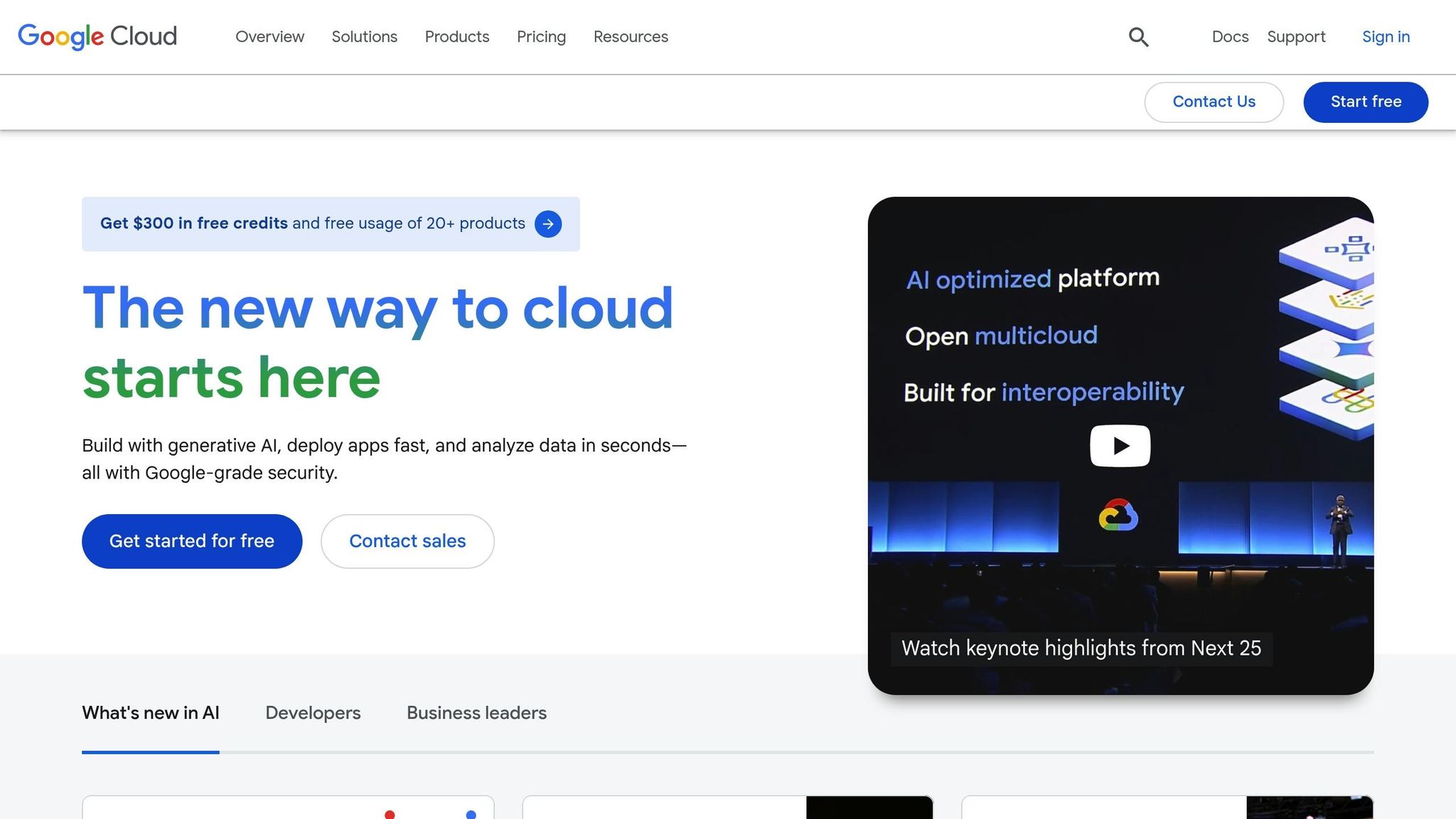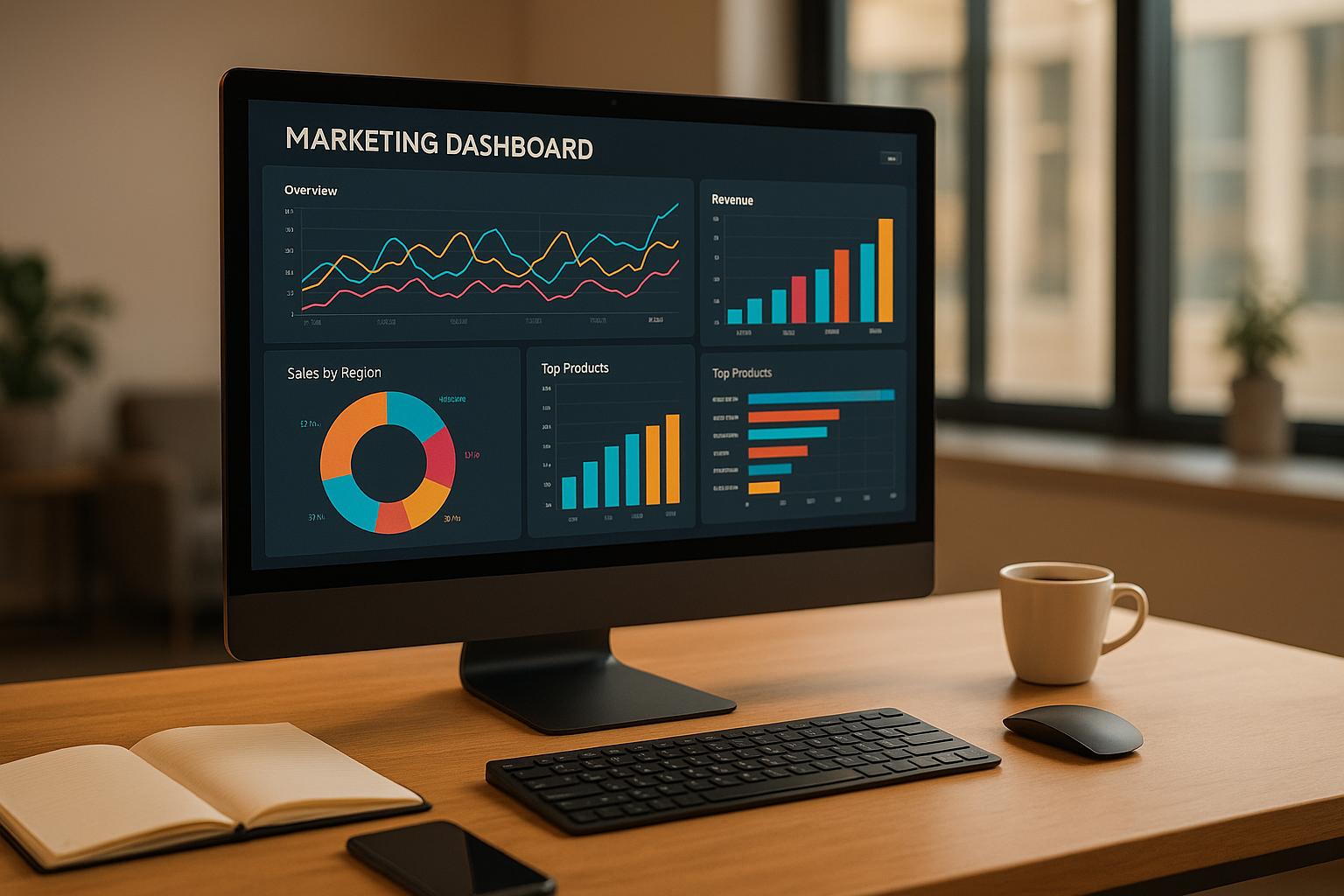Analytics tools must handle today's data complexities while staying ready for future challenges. Without flexibility, businesses risk costly migrations, integration issues, and compliance failures. Here's what to prioritize when choosing analytics platforms:
- Real-Time Insights: Tools should provide instant data updates for timely decision-making.
- Integration Capabilities: Open APIs and pre-built connectors simplify linking with existing systems.
- AI-Powered Features: Predictive analytics and anomaly detection help anticipate trends and automate responses.
- Scalability: Platforms must handle growing data volumes and adapt to new channels effortlessly.
- Privacy Compliance: Support for consent management, encryption, and jurisdiction-specific regulations is crucial.
- Custom Dashboards: Tailored views and role-based access streamline usability across teams.
How to future-proof your marketing analytics stack with GCP and Supermetrics

Common Problems When Future-Proofing Analytics
Future-proofing analytics means sidestepping the challenges that can derail business growth. Even small missteps can snowball into costly obstacles. Here’s a closer look at some of the most common issues that prevent analytics systems from keeping up.
Disconnected Data and Integration Problems
Data silos are a persistent problem for marketing teams. When tools like email platforms, social media dashboards, CRM systems, and web analytics don’t communicate, you’re left with fragmented insights. Each tool tells part of the story, but no one has the full picture of the customer journey.
As companies grow, this problem often worsens. A business might start with tools like Google Analytics and Mailchimp, then add platforms like Facebook Ads Manager, Salesforce, and others. Without proper integration, teams waste hours manually combining data, and opportunities for personalized customer experiences slip away.
This lack of integration makes attribution a guessing game, leaving marketers to make budget decisions based on incomplete data. As data volumes increase, these inefficiencies ripple across the organization, resulting in missed opportunities and reduced performance.
Growth and Performance Problems
Analytics platforms that work well for small-scale operations often struggle under the weight of rapid growth. When a business scales to millions of events, multiple product lines, or global markets, performance bottlenecks can grind operations to a halt.
Reports that once ran in seconds may now take hours - or even days. Dashboards that used to load instantly start timing out. These delays hinder teams from making timely decisions, turning what were once minor inconveniences into critical business risks.
Costs can also spiral out of control. Many platforms charge based on data volume, and as your data grows, so do your expenses. Businesses often face tough choices, like deleting historical data or limiting what they collect, just to manage costs.
The challenges multiply with the addition of new marketing channels. Whether it’s TikTok, connected TV advertising, or emerging platforms, each new channel introduces unique data formats and requirements. Systems that can’t quickly adapt leave teams scrambling to retrofit their tools, further straining performance. And as data privacy regulations become more complex, these limitations only add to the pressure.
Privacy and Legal Compliance Issues
Navigating privacy regulations is an ever-evolving challenge. The introduction of GDPR was just the start - state-specific laws in the U.S. and international regulations demand flexible systems that can handle varying requirements.
Each law has its own rules for data collection, storage, and user consent, making compliance a technical headache. What works in one jurisdiction might violate rules in another. Businesses operating across multiple states or countries need analytics platforms capable of managing these differences seamlessly.
This means supporting features like granular consent management, where users can opt out of specific types of tracking, and data portability, allowing individuals to download their information. Systems must also honor "right to be forgotten" requests with robust deletion capabilities.
Unfortunately, many existing analytics tools weren’t built with these requirements in mind. They often collect data indiscriminately, making it nearly impossible to implement proper consent or deletion processes retroactively.
Outdated Technology and Vendor Dependency
Legacy systems can be a major roadblock. Older platforms often struggle to integrate with modern tools, support new data formats, or scale effectively. Instead of enabling growth, they act as digital dead weight, holding back your marketing efforts.
Vendor dependency compounds the issue. When you’re locked into a proprietary system, you’re at the mercy of that vendor’s decisions. If they raise prices, discontinue features, or even shut down, you’re left scrambling to migrate to a new solution - an expensive and disruptive process.
Technical debt also builds up over time. Custom integrations and workarounds create fragile systems that break with even minor changes. What starts as a simple setup can quickly turn into a patchwork of fixes that require constant maintenance, making it harder to adopt new technologies.
Adding to the challenge is the shrinking talent pool for maintaining legacy systems. As technology evolves, finding developers with the necessary skills becomes more difficult - and more expensive. Without addressing these issues, businesses risk being left behind in a competitive landscape.
Missing Real-Time and Prediction Features
In today’s fast-paced world, batch processing no longer cuts it. Real-time analytics are essential for making quick adjustments. For instance, if a social media campaign isn’t performing well, real-time insights let you tweak targeting or creative elements within hours, not days.
Predictive analytics are equally critical. Businesses need tools that can forecast customer lifetime value, predict churn, and identify the best times to engage specific audience segments. Without these capabilities, companies are stuck reacting to trends instead of staying ahead of them - a disadvantage that grows more pronounced over time.
Important Features to Look For in Analytics Tools
The challenges mentioned earlier don’t have to throw your analytics strategy off course. By focusing on key features, you can address issues like integration, scalability, and compliance, ensuring your systems keep pace with your business as it grows. Here's what to look for when assessing analytics platforms.
Real-Time Analytics and Reports
Data delays can undermine decisions, but real-time analytics solve this by providing instant insights into campaign performance and user behavior. This allows you to act quickly during critical moments, like Black Friday sales, product launches, or viral social media trends. If click-through rates start to dip or conversion funnels break, you can respond before it impacts revenue.
Real-time tools need more than just speed - they should offer streaming analytics with sub-second latency and automated alerts for performance thresholds. Choose a platform that can process thousands of events per second without compromising dashboard performance or reporting accuracy.
These capabilities benefit multiple teams:
- Customer service can monitor user behavior as tickets come in.
- Sales teams can prioritize leads based on recent activity.
- Marketing teams can pause underperforming ads and reallocate budgets in minutes.
Easy Integration and Open APIs
Seamless integration is a must for any analytics tool. Open APIs ensure your platform can connect with existing tools and adapt as your needs change. Look for pre-built connectors for popular platforms like Salesforce, HubSpot, Google Ads, and Shopify, along with RESTful APIs for custom integrations.
High-quality API documentation, SDKs, and webhook support are essential for smooth implementation. Don’t overlook security - features like OAuth 2.0, API rate limiting, and granular permission controls keep your data safe while enabling flexibility. Some platforms even offer middleware solutions to handle complex data transformations.
AI-Powered Insights and Automation
AI capabilities can elevate your analytics by detecting anomalies, predicting trends, and automating responses.
- Anomaly detection flags unusual patterns, like sudden drops in conversion rates or unexpected traffic spikes, so you can address issues early.
- Predictive analytics forecasts customer behavior, campaign outcomes, and revenue trends, using advanced models to refine accuracy.
- Automated optimization acts on insights by adjusting ad bids, pausing underperforming campaigns, or triggering email sequences based on user behavior. The best tools allow you to set guardrails, ensuring automation works alongside human oversight.
Natural language processing is another powerful feature, analyzing customer feedback, social media mentions, and support tickets to uncover hidden trends in unstructured data.
Growth Capacity and Speed
As your business grows, your analytics platform needs to scale with it. Look for cloud-native systems that support horizontal scalability, optimized query performance, and predictable pricing models.
Features like data partitioning and indexing strategies ensure smooth performance, even with billions of events. Be mindful of pricing - some platforms charge based on data volume, which can lead to unexpected costs. Compute-based pricing, which aligns with actual usage, often provides more predictable expenses. Also, consider data retention costs if you plan to keep historical data for long-term analysis.
For global businesses, multi-region deployment is crucial. Platforms should replicate data across regions for faster access and compliance with local data regulations.
Strong Data Privacy and Legal Controls
With increasing data privacy standards, your platform must offer robust consent management, data minimization, and encryption (AES-256).
Consent management platforms (CMPs) should integrate seamlessly, maintaining detailed audit trails of what data was collected, when consent was given or withdrawn, and how it’s processed. For international businesses, cross-border data transfer capabilities are vital. Platforms should support data localization while still enabling unified reporting. Some advanced tools use federated analytics to analyze data locally while aggregating insights globally.
Custom Dashboards and User Permission Controls
Customizable dashboards and role-based access ensure that every team gets the insights they need without unnecessary complexity. Advanced platforms let you create tailored experiences for different roles - for example, sales teams might focus on lead scoring, while customer success teams track usage analytics.
If you work with clients or external stakeholders, white-label capabilities can be a game-changer. Features like custom branding, domain mapping, and embedded analytics allow you to share data seamlessly while maintaining a professional appearance.
sbb-itb-5174ba0
How to Choose Future-Ready Analytics Tools
Selecting the right analytics platform is a balancing act. You need a tool that meets your current needs while staying adaptable to future demands. With challenges like fragmented data and rapid growth, it’s crucial to pick a solution that supports both short-term goals and long-term scalability. Start by examining your current data setup and envisioning how your requirements might evolve.
Review Current and Future Data Needs
Begin by analyzing your current data environment. Estimate the volume of data you’re handling now and project how it might grow over time. This helps you define capacity needs and avoid outgrowing your platform too quickly.
Think about how long you need to store your data. For example, some industries require seven years of data for compliance, while others only need 18 months. Make sure the platform can handle these retention requirements.
Also, consider how your data needs might become more complex. While basic metrics like page views or conversions may suffice today, you might later require advanced features like behavioral scoring, attribution modeling, or predictive analytics. Choose a platform that can work with both structured data (like sales numbers) and unstructured data (like customer reviews or social media posts) without needing separate systems.
Check Integration and Scalability
Integration is key. Test how easily the platform connects with your existing tools through trials or sandbox environments. Look for systems that support bidirectional data flow, allowing you to both extract insights and push data into other platforms.
Scalability is another must-have. Cloud-native platforms generally scale better than older systems modified for cloud use. Look for features like auto-scaling, which adjusts resources automatically during high-demand periods - think product launches or seasonal campaigns. This ensures consistent performance without manual intervention.
Also, take a close look at the pricing model. Make sure it’s transparent and won’t lead to unexpected costs as your data volume increases.
Evaluate Vendor Support and Updates
Reliable support and regular updates can make or break your experience with a platform. Research the vendor’s stability and responsiveness. Do they offer a dedicated customer success manager for enterprise clients, or is support limited to a ticketing system? Look for detailed documentation, video tutorials, and active user communities to help you navigate the platform.
Security updates are equally important. Vendors who provide frequent updates and patches demonstrate a commitment to compliance and data protection. Ask about their incident response process and how quickly they notify customers of security issues.
Use the Marketing Analytics Tools Directory

Once you’ve outlined your technical and support needs, simplify your vendor research using the Marketing Analytics Tools Directory. This resource categorizes analytics platforms based on business needs, such as real-time analytics, campaign tracking, or audience insights. It’s a time-saver, allowing you to compare tools side-by-side instead of researching each vendor individually.
The directory is tailored to U.S. businesses, ensuring compliance with local regulations and compatibility with popular American business tools. You can filter options by company size, industry, or specific features like A/B testing or enterprise dashboards. Featured listings provide in-depth details on platform capabilities, pricing, and support, while the FAQ section helps you ask the right questions during vendor demos.
Start with the directory to narrow your options, then test your top three choices through trials and demos. This method ensures you explore emerging platforms without getting overwhelmed by too many choices.
Conclusion: Building Long-Term Analytics Success
To keep your analytics strategy relevant, it’s crucial to establish a foundation that can adapt as your business and technology evolve. The analytics world moves fast, with new privacy laws, AI advancements, and data sources constantly emerging. Companies that invest in adaptable, scalable platforms are better positioned to embrace these changes instead of scrambling to keep up.
Focusing only on short-term needs often results in expensive migrations and disjointed data systems. Instead, aim for platforms that offer real-time data processing, reliable APIs, AI-driven insights, and strong compliance measures. While these features might feel excessive now, they’ll become indispensable as your business grows and your data needs expand.
Vendor reliability is just as important as platform capabilities. Advanced features lose their value without consistent updates and dependable support. Look for vendors with a solid track record, clear development roadmaps, and active user communities - these are signs of a partner you can count on for the long haul.
The Marketing Analytics Tools Directory simplifies your decision-making process by categorizing platforms based on your business needs. Whether it’s industry-specific tools, scalability for your company size, or must-have features, the directory helps you quickly identify the best-fit solutions. This focused approach ensures you make smarter, faster decisions without overlooking emerging tools that could perfectly suit your requirements.
Choose analytics tools that evolve with your business, integrate seamlessly with new technologies, and adapt to changing regulations. By prioritizing future-ready capabilities and leveraging the directory to guide your selection, you’ll lay the groundwork for analytics success that lasts.
FAQs
What steps can businesses take to ensure their analytics tools comply with changing privacy regulations across regions?
To keep up with changing privacy regulations, businesses need to routinely review their data practices and establish solid data protection policies. Understanding and adhering to major laws like GDPR, CCPA, and various state-specific regulations in the U.S. is a critical step to ensure compliance.
On top of that, using analytics tools equipped with privacy-focused features can make a big difference. These tools should allow for flexible adjustments to data collection methods as laws evolve. By staying on top of legal updates and proactively refining internal policies, businesses can better protect user data and remain compliant across different regions.
What risks come with using outdated analytics systems, and how can businesses address them?
Outdated analytics systems can cause a host of problems, starting with security risks. Older platforms often lack the latest defenses, leaving them vulnerable to attacks. Beyond that, system failures can become a recurring headache, with repairs that are both expensive and time-consuming. Another major issue? These systems often can’t work well with newer technologies, making it tough to keep up with modern business demands.
To tackle these challenges, businesses should focus on keeping systems up-to-date with regular updates and security patches. It’s also wise to invest in tools that strengthen protection and outline a clear modernization plan. This could mean gradually phasing out outdated systems and adopting scalable, future-ready solutions that support smooth operations and set the stage for long-term success.
Why is real-time data processing essential for businesses today, and what features should an analytics platform include to support it?
Real-time data processing plays a crucial role in helping businesses make swift, well-informed decisions. By offering up-to-the-minute insights into customer behavior, market trends, and operational performance, it enables companies to stay responsive, boost efficiency, and maintain an edge in competitive, fast-moving industries.
For real-time data processing to work effectively, an analytics platform needs to have specific features, such as continuous data ingestion, in-memory computing, scalable infrastructure, and real-time analytics engines. These components allow businesses to instantly process and analyze streaming data, ensuring quicker reactions to changes and delivering improved experiences for customers.


